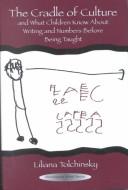| Listing 1 - 3 of 3 |
Sort by
|

ISBN: 0805838430 1410607194 9781410607195 9780805838435 0805844848 9780805844849 1282322079 9786612322075 9781135647964 9781135648008 9781135648015 9781282322073 6612322071 Year: 2003 Publisher: Mahwah, N.J. : L. Erlbaum Associates,
Abstract | Keywords | Export | Availability | Bookmark
 Loading...
Loading...Choose an application
- Reference Manager
- EndNote
- RefWorks (Direct export to RefWorks)
This book provides a thrilling description of preliterate children's developing ideas about writing and numerals, and it illustrates well the many ways in which cultural artifacts influence the mind and vice versa. Remarkably, children treat writing and numerals as distinct even before they have received any formal training on the topic, and well before they learn how to use writing to represent messages and numerals to represent quantities.In this revolutionary new book, Liliana Tolchinsky argues that preliterate children's experiences with writing and numerals play an essential and
Developmental psychology --- Cognitive psychology --- Children --- Child development. --- Literacy. --- Numeracy. --- Mathematical ability --- Mathematics --- Statistics --- Illiteracy --- Education --- General education --- Child study --- Development, Child --- Developmental biology --- Writing --- Writing. --- Development
Book
ISBN: 0192667009 9780192667007 9780192849984 Year: 2023 Publisher: Oxford Oxford University Press
Abstract | Keywords | Export | Availability | Bookmark
 Loading...
Loading...Choose an application
- Reference Manager
- EndNote
- RefWorks (Direct export to RefWorks)
This book explores how schoolchildren and adolescents employ language in different communicative settings. The authors demonstrate how language development is affected by the language and culture in which it evolves, and use brain studies to provide a deeper explanation of developmental changes in language behavior.
Book
ISBN: 1281181935 9786611181932 9087903189 Year: 2007 Publisher: Rotterdam ; Taipei : Sense Publishers,
Abstract | Keywords | Export | Availability | Bookmark
 Loading...
Loading...Choose an application
- Reference Manager
- EndNote
- RefWorks (Direct export to RefWorks)
Permanent external representations in the form of drawings, maps, musical scores, figures, graphs, writing, numerals, hallmarks and signatures are part of our daily landscape and permeate most social activities almost from the moment we are born. This book is about humans’ appropriation, understanding and use of external representations. The authors, all established researchers, present first hand research in the domain of notational knowledge. They reflect on the peculiar features and representational mechanisms of notational systems based on cultural conventions such as musical notation, graphs, writing, numerals and mathematical notation as well as on unique notations that children create in new situations. There are two chapter clusters in the book. The first cluster considers these systems from a historical perspective. Authors focus on the characteristics of these systems in different cultures and at different times and analyze the ways in which notation systems evolve and transform our social interactions, our ideas about language and about other domains of knowledge. The second cluster of chapters takes a developmental perspective. In these chapters the authors focus on the individual appropriation of these systems and highlight the interest for studying permanent external representation as a domain of human development. In particular, authors explore the ways in which notation systems are acquired, the extent to which children are sensitive to their distinguishing constraints and to the particular contents they come to represent and question the future of notations. Both the historical and the developmental perspectives are crucial for understanding the relations between culture and cognition. We can learn about the human mind through analyzing the social processes of invention and transformations of cultural artifacts and also through the individual and social process of appropriation of the cultural artifacts already created. A common theme in the book is that permanent external representations are not just instruments for expressing given information or tools for communication, they are objects to think with. They not only keep record of existing knowledge but are themselves instrumental in the creation of new knowledge. There are conceptual, linguistic and esthetic distinctions that may be unattainable without notational means. The book will be useful for students of psychology, philosophy, linguistics and education and for every one interested in understanding ways in which knowledge is generated, recorded and scrutinized. Although there are other volumes on writing, literacy, and numeracy, and some chapters are available in other volumes on the history of writing, mathematics or musical notation, the present proposal is unique and timely for the range of notational systems it embraces, for including both an historical and a developmental perspective and for the number of theoretical frameworks it discusses.
Signs and symbols --- Mathematical notation --- Psychological aspects.
| Listing 1 - 3 of 3 |
Sort by
|

 Search
Search Feedback
Feedback About
About Help
Help News
News